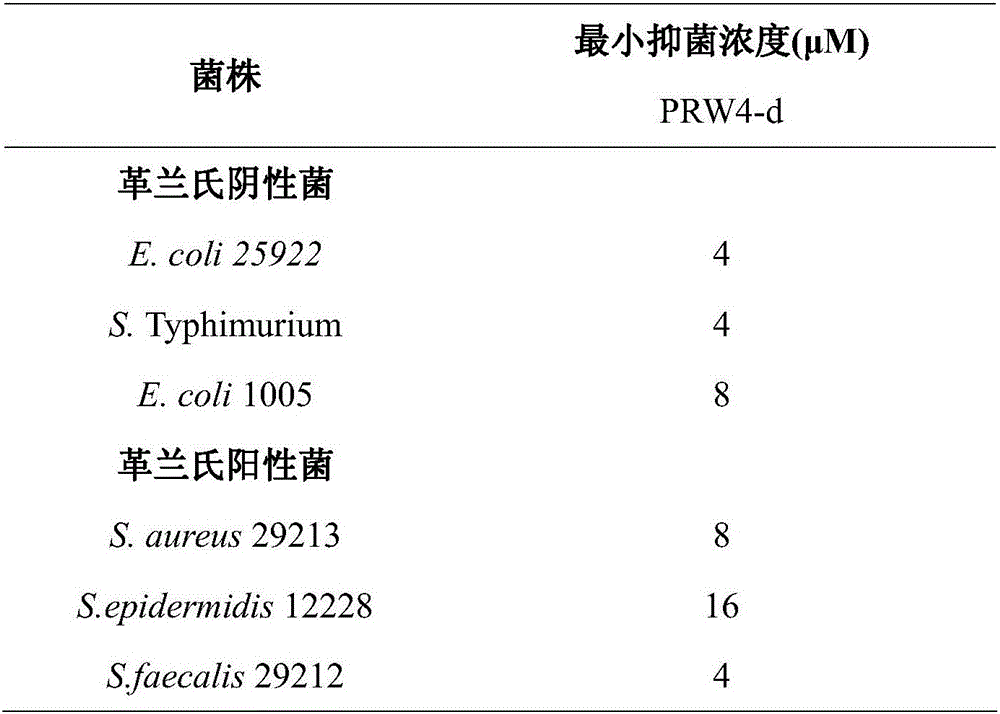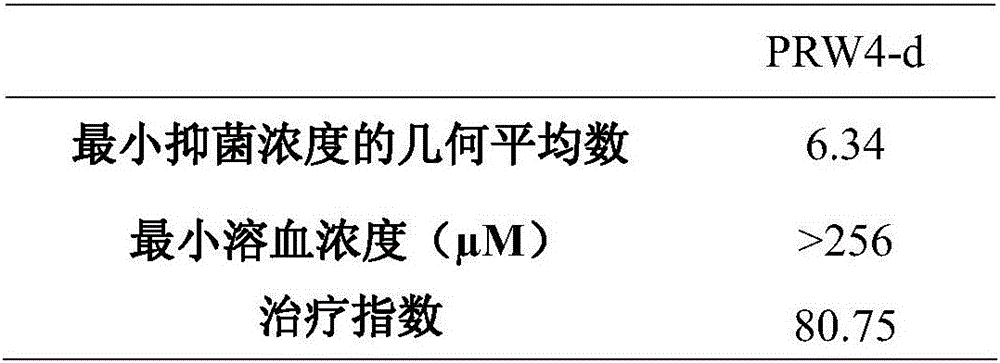D-amino acid antibacterial peptide PRW4-d and preparation method and application thereof
An antimicrobial peptide and amino acid technology, applied in the biological field, can solve the problems of weak antibacterial activity, high synthesis cost, protease sensitivity, etc., and achieve the effect of low hemolytic activity, simple preparation technology and high cell selectivity
- Summary
- Abstract
- Description
- Claims
- Application Information
AI Technical Summary
Problems solved by technology
Method used
Image
Examples
Embodiment 1
[0015] Design of Antimicrobial Peptides
[0016] First, the 16 amino acid sequence of the N-terminal of the cationic antimicrobial peptide PMAP-36 containing 36 amino acids derived from porcine bone marrow was intercepted, named RI16, and the sequence after interception has a perfect amphipathic structure. Secondly, an imperfect amphiphilic antimicrobial peptide was designed based on the α-helical protein framework and folding principles to obtain PRW4.
[0017] Using the antimicrobial peptide PRW4 as a template, the amino acids cysteine (Cys), aspartic acid (Asp), isoleucine (Ile), proline (Pro) and D-color with different helical tendencies were used respectively. Tryptophan in PRW4 is replaced by D-Trp. At the same time, in order to study the important role of arginine (Arg), all Lys in PRW4 were replaced by Arg. Wherein, the amino acid sequence of the antimicrobial peptide PRW4-d replaced with D-tryptophan (D-Trp) is shown in Table 1.
[0018] Table 1 Amino Acid Sequen...
Embodiment 2
[0022] Synthesis of Antimicrobial Peptides by Solid Phase Chemical Synthesis
[0023] 1. The preparation of antimicrobial peptides is carried out one by one from the C-terminal to the N-terminal, and is completed by a peptide synthesizer. First, Fmoc-X (X is the first amino acid at the C-terminal of each antimicrobial peptide) is inserted into Wang resin, and then the Fmoc group is removed to obtain X-Wang resin; then Fmoc-Y-Trt-OH (9 -Fmoxy-trimethyl-Y, Y is the second amino acid at the C-terminus of each antimicrobial peptide); according to this procedure, it is synthesized from the C-terminus to the N-terminus until the synthesis is completed, and the side of the Fmoc group is removed Resin for chain protection.
[0024] 2. Add a cleavage reagent to the peptide resin obtained above, react for 2 hours at 20°C in the dark, filter; wash the precipitate with TFA (trifluoroacetic acid), mix the washing liquid with the above filtrate, concentrate with a rotary evaporator, and th...
Embodiment 3
[0027] Embodiment 3: the mensuration of antimicrobial peptide antibacterial activity
[0028] 1. Determination of antibacterial activity: Prepare the peptide as a storage solution for use. The minimum inhibitory concentrations of several antimicrobial peptides were determined by the broth microdilution method. Using 0.01% acetic acid (containing 0.2% BSA) as the diluent, a series of gradient antimicrobial peptide solutions were sequentially prepared using the double dilution method. Take 100 μL of the above solution and place it in a 96-well cell culture plate, then add an equal volume of the bacteria solution to be tested (~10 5 individual / mL) in each well. Positive controls (containing bacterial fluid but not antimicrobial peptides) and negative controls (neither bacterial fluid nor peptides) were set up. Incubate at a constant temperature of 37°C for 20 hours, and the minimum inhibitory concentration is the one where no turbidity is seen at the bottom of the well with th...
PUM
 Login to View More
Login to View More Abstract
Description
Claims
Application Information
 Login to View More
Login to View More - R&D
- Intellectual Property
- Life Sciences
- Materials
- Tech Scout
- Unparalleled Data Quality
- Higher Quality Content
- 60% Fewer Hallucinations
Browse by: Latest US Patents, China's latest patents, Technical Efficacy Thesaurus, Application Domain, Technology Topic, Popular Technical Reports.
© 2025 PatSnap. All rights reserved.Legal|Privacy policy|Modern Slavery Act Transparency Statement|Sitemap|About US| Contact US: help@patsnap.com



